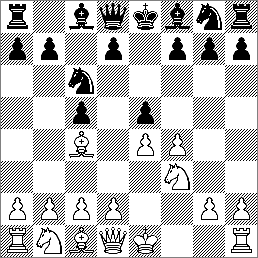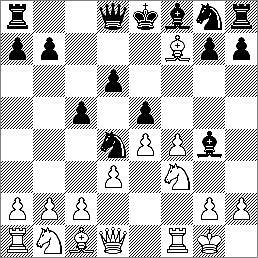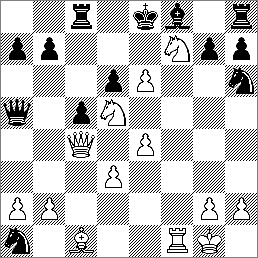A new chess game by Paul Morphy? It has been over thirty years since new Morphy games have been given to the world. We are unaware of any appearing since David Lawson published his significant findings in the British Chess Magazine for August 1978 and September 1979. But recently a strong candidate came to light when chess historian, author and researcher Jacques N. Pope reviewed chess columns over 150 years old.
Nick made the discovery while working on the extraordinarily useful and well-stocked pages of the Jack O'Keefe Project at his web site, Chess Archaeology, which offers a mega-collection of full, original chess columns from dozens of historic American newspapers, available for the convenience and perusal of all chess history lovers (http://www.chessarch.com/excavations/excavations.php).
The game appeared in the 9 November 1857 issue of the Syracuse Daily Standard, then edited by "the Syracuse Chess Club." This collective pseudonym for upstate New York players was in all probability a small group led by William Orville Fiske, younger brother of the better known Daniel Willard Fiske, editor of the New York City-based Chess Monthly, as well as the young George N. Cheney, the Syracuse area's most brilliant player. The column giving the game included the following paragraph, one rather cryptic regarding the game's source:
|
B. F. B., Brooklyn, of Calliopean, Nothing-to-Wear (as well as sundry fine poems of his own,) celebrity, has favored us with an interesting letter containing one of the Tournament games between Paul Morphy and Theodore Lichtenhein. It is a splendid affair, though some of our strong players audaciously declare it as their opinions that the 4th, 7th, and 16th moves of the Defense admit of improvement. We give as our unanimous and decided opinion that it is very easy criticizing games after they are played.
|
Unfortunately the available image of the column, as can be seen from the original, below, is somewhat difficult to make out. We believe the initials are most likely "B.F.B." This is strongly suggested through examination of the internal references. "Calliopean," even though capitalized and thus suggestive of a noun, works as an adjective here with a double meaning, both meanings appropriate in context. First, "Calliope" in Greek mythology is the Muse of eloquence and heroic poetry. The use refers to the "beautiful voiced." Second, and rather ironically in its oppositeness, the word subsequently came to mean "piercingly loud." A "calliope" was a steam-driven musical instrument notorious for its shatteringly loud sound. "Nothing To Wear" refers to the highly popular, lengthy poem by that name satirizing the extravagance of New York's well-to-do, published in Harper's Weekly in 1857. Thus "Calliopean" would refer to both the "heroic" poem (with a gentle jibe at the satirical poem itself) as well as the shrill voice of public popularity surrounding it. Although the poem was originally published anonymously, it eventually became known that William Allen Butler, the son of Benjamin Franklin Butler, had written "Nothing to Wear."
Both elements, "Calliopean" as well as the poem's title, modify the "celebrity" referred to in the Daily Standard passage, while the parenthetical "(as well as sundry fine poems of his own,)" (emphasis added) indicates someone likely close to, but other than, the Daily Standard's correspondent, B.F.B., authored "Nothing to Wear." Taken together, these allusions strongly suggest that B.F.B refers to Benjamin Franklin Butler, the New York native and one-time Attorney General of the United States, and father of the author of "Nothing to Wear."
While a direct connection between Butler and chess remains to be found, it is revealing that Benjamin Franklin Butler learned law while clerking for the future President of the United States, Martin Van Buren. Martin Van Buren's son, John Van Buren, in turn clerked for Butler. John Van Buren was chosen by the New York Chess Club's Testimonial Committee to present Paul Morphy with the silver and gold chess men and pearl inlaid board on the American champion's triumphal return from Europe, celebrated 25 May 1859, at the chapel of New York University. He did so, recounting for the audience in some detail Morphy's chess career. New York Times, 26 May 1859.
Another complicating factor is that the game's score in the Syracuse Daily Standard appears below the column's chess problem without directly naming the players. The 9 November 1857 column refers to another game, one supplied by a "Winfield Smith, of Milwaukee," but this one was to appear in the following week's column. It did not as it had been mislaid, but there was no suggestion it was the game published 9 November. Syracuse Daily Standard, 16 November 1857. The only other game referred to in the 9 November 1857 column in which the game below appears, is the game under discussion. It would seem illogical for the editor(s) of the Daily Standard to refer to specific game moves ("4th, 7th, and 16th moves of the Defense") without contemporaneously supplying the game to which they refer. It also appears, from review of all the known Morphy - Lichtenhein games, that no other game between the two men appears in which the "4th, 7th, and 16th moves of the Defense" could reasonably be criticized. The absence of names directly at the top of the game is a lapse that occurred more frequently then than today. It also would account for the game being overlooked by past Morphy game collectors.
The status of this game, including when and where it was played, offers an intriguing possibility. It is well known that Morphy defeated Theodor Lichtenhein at the First American Chess Congress, New York 1857, by the score of 3-0, with 1 draw, and that all four games appear in the tournament book. Not every source, however, gives this precise score. Frank Leslie's Illustrated Newspaper for 14 November 1857 records the total for Morphy against Lichtenhein as 5-0, with 1 draw. This in itself would mean little were it not for the fact that a fourth win by Morphy against Lichtenhein appears in the February 1858 issue of Fiske's Chess Monthly along with other games under the heading "Chess in the Late Congress" (see pp.50-51). Could it be possible that Morphy, waiting for Paulsen to complete his round, in fact played two additional, although officially unnecessary, games with Lichtenhein during the Congress, thus accounting for the Chess Monthly game and, now, this one? The line between games played "at" such early congresses, here as well as in Europe, and those played officially "in" such events, often was blurred in the press during these early years of chess reportage. In other words, could it be possible that the game below represents the "fifth" Morphy win over Lichtenhein, as reported in Frank Leslie's? If so, not only does the game represent a hitherto "lost" Morphy game, but an even rarer one: a new Morphy game played in the United States on equal terms and under tournament-like, if not actual tournament, conditions.
Nothing conclusive can yet be said, but it appears quite likely, to me, at least, that whatever the precise venue, Nick Pope has found a forgotten Paul Morphy game. All those interested in American chess history owe him thanks for his diligence.
The game with its original annotations follows, along with Nick's recounting of his research, and then the image of the original column.
Unknown Morphy Game?
Morphy-Lichtenhein 1857
by Nick Pope
I checked the following Morphy collections for any sign of this game: Frère's Morphy's Games of Chess and Frère's Problem Tournament, 1859; Stanley's Paul Morphy's Match Games, 1859; Lange's Paul Morphy. Skizze aus der Schachwelt, 1859; Lange's Paul Morphy. Skizze aus der Schachwelt. Zweiter Theil, 1859; Preti's Choix des Parties les Plus Remarquables Jouées par Paul Morphy en Amérique, 1859; Löwenthal's Morphy's Games, 1860, Appleton Edition; Löwenthal's Morphy's Games, 1860. Bohn Edition; Lange's Paul Morphy. Skizze aus der Schachwelt, 1881; Maróczy's Paul Morphy, 1909; Sergeant's Morphy's Games of Chess, 1957; Lawson's Paul Morphy, the Pride and Sorrow of Chess, 1976; and Shibut's Paul Morphy and the Evolution of Chess Theory (with addendum), 1993.
I then checked the Morphy and Lichtenhein games found in Levy & O'Connell's Oxford Encyclopedia of Chess Games, 1981. And I also checked Fiske's The Book of the First American Chess Congress, 1859, for all the Morphy games, Lichtenhein games, and Sicilian games played during the Congress. The following game was not played in the tournament, but could very well be one of the off-hand games played by Morphy during the event.
|
| | Morphy,PC — Lichtenhein,T | |
| B21 | Sicilian: McDonnell | |
| 1857 | USA New York |
|
Annotations by Syracuse Chess Club (Syracuse Daily Standard)
- 1.e4 c5 2.f4 e5 3.Nf3 Nc6 4.Bc4

- 4...d6 5.d3 Bg4 6.0-0 Nd4
- A positive oversight; he might have played instead, 6...Nf6, or, perhaps, 6...f5.
- 7.Bxf7+
- Taking prompt advantage of his adversary's error. The game to this point is identical with one played some time since between Dr. B. I. Raphael, of New York, and Mr. Montgomery, of Philadelphia.
 - 7...Kxf7
- The capture of this bishop was ill-advised, as it lets in an overwhelming attack upon him; better to have played 7...Kd7. The little game mentioned in the proceeding [sic] note, ran on thus: 7...Ke7 8.fxe5 Bxf3 9.Bg5+ Kd7 10.e6+ Kc6 11.Bxd8 Bxd1 12.Be8#
- 8.Ng5+ Ke8 9.Qxg4 Nxc2 10.fxe5
- Threatening to win the queen by 11.Rxf8+, and then playing 12.Ne6; he also threatens to play 11.Nf7 winning the rook.
- 10...Nh6
- The only move.
- 11.Qe6+
- He could also have checked with 11.Qh5+ since Black could not have interposed 11...g6 without losing two minor pieces for the rook. The move made, however, is undoubtedly the best.
- 11...Qe7 12.Qc4 Nxa1 13.e6 Rc8
- To guard against the fatal check 14...Qb5+.
- 14.Nc3 Qd8 15.Nd5 Qa5 16.Nf7

- 16...Nxf7 17.exf7+ Kd7 18.Bd2 Qxd2 19.Qb5+ Ke6
- To interpose 19...Rc6 is equally disastrous.
- 20.Qe8+ 1-0
Syracuse Daily Standard, 1857.11.09

Introduction © 2011 John S. Hilbert. All rights Reserved.
© 2011 Nick Pope. All rights Reserved.
|



